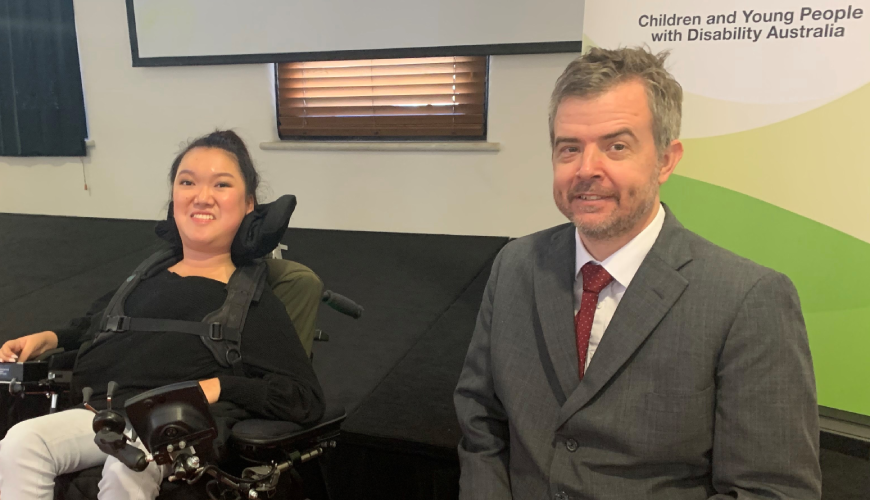Inclusive education: Why silence and inaction is not the answer

DR BEN GAUNTLETT
DISABILITY DISCRIMINATION COMMISSIONER
AUSTRALIAN HUMAN RIGHTS COMMISSION
QUEEN VICTORIA WOMEN'S CENTRE, MELBOURNE
28 OCTOBER 2019
Ladies and gentlemen, distinguished guests, I acknowledge my deep respect to the traditional owners of the land on which the Queen Victoria’s Women Centre is situated, the Wurundjeri people of the Kulin nation. I pay respect to their Elders past, present and emerging and acknowledge their continuing connection to the land. I also acknowledge any other Aboriginal and Torres Strait Islander Elders or community members who are here today and acknowledge their presence.
Disability inclusion is more than a plan or piece of legislation – it is a mindset that is implemented by a course of conduct that is verifiable. Educational institutions can affect attitudes for a generation. Children, particularly young children, do not see prejudice; they see friends, they see opportunity, and, above all, they see the whole person. They often try and rationalise a person’s characteristics against their own life experiences. The complexity of the issue rarely deters the child.
But, in education and disability policy in Australia, we seem to not want to look closely as to why aspects of our education system are not inclusive. A potential choice of integration (without any adjustment to the model of teaching) is not inclusive.
For change to occur there needs to be respectful debate about training, resources and approaches. We need to be balanced and objective in our arguments too. Often the policies concerning people with disability in education are the result of historical decisions of different decision-makers; different values and a unique built environment.
Today I’ve been asked to launch two reports. First, a report entitled “Time for change: the state of play for inclusion of students with disability”. Second, a report entitled, “Towards inclusive education: A necessary process of transformation”. The reports are sobering reading. They should be seen though as part of a journey. Particularly when children and intersectionality issues are involved, we always need to be careful to ensure children are respectfully consulted and I’m sure future research will aspire to focus on these consultations.
There are also four fact sheets produced by Children and Young People with Disability Australia:
- What is inclusive education?;
- The benefits of inclusive education;
- Addressing ableism in education; and
- Transformation to inclusive education: the next steps.
I commend CYDA for producing these fact sheets, as the more accessible we make information the better it is for improving disability policy in Australia. This includes producing documents in Easy Read and Plain English formats.
I’m going to discuss both reports briefly before talking about inclusive education and its importance in building community values. Ideally, when you leave today you will remember three issues:
- Education policy can greatly influence people’s perception of disability for generation. Therefore, we need to be careful to allocate appropriate resources to ensure what, how, when and to who matters are taught is carefully considered. This includes training of professions that may have an impact on people with disability.
- Education in schools, training courses and universities is more than just maths, reading and writing. It includes lessons not taught formally and how those lessons are taught – these impact upon perceptions of diversity and inclusion; and
- When criticising education policy, we need to be constructive. Many people involved in the education system are doing their best and it is not enough just to spot a problem. We need to volunteer solutions.
The culture of silence regarding disability in Australia is over but as a result we need to build bridges and not bonfires.
The lack of compliance with Article 24 of the Convention on the Rights of Persons with Disability and General Comment Number 4 is a common global phenomenon. Fixing the issues will not occur overnight and must occur while people are being educated. Changes will be piecemeal and incremental.
Time for change: The state of play for inclusion of students with disability
This report highlights the results from the 2019 Children and Young People with Disability Australia National Education Survey.
I think it is important to acknowledge that government does seek to provide resources to assist children to access education and there are good practices in Australia. However, issues remain with separation (whether explicit or by a lack of resources), exclusion from events or activities, levels and the equity of support provided, a lack of training for teachers and appropriate support, low expectations, bullying, and the use of a wide variety of restraints.
The use of data to support the arguments for changing the approach to education is to be commended. Carefully gathered data is of vital importance in arguing for any policy change.
Towards inclusive education: A necessary process of transformation
This report is a significant piece of scholarship from Dr Kathy Cologon of the Department of Educational Studies at Macquarie University. It is impossible to do justice to the report, but some key themes do emerge. First, there seems to be confusion as to what is meant by “inclusive education”. It is not the presence of a ramp; the presence of a teaching assistant; or an alteration to a teaching curriculum. Rather, it is the meaningful inclusion of people with disability in the design and operation of the education system in compliance with Article 24 of the Convention on the Rights of Persons with Disability. Second, the benefit to all students of inclusive education is often overlooked (and probably needs to be better articulated).
Third, a policy weakness, such as teacher training, does not mean something is impossible. Training and constructive discussion is needed. The policy changes are multi-faceted. Fourth, exceptions to policies in education can be normalised without effective rules and data collection mechanisms.
Disability in Australia
In the year 2018-2019 there were 891 complaints to the Australian Human Rights Commission concerning disability discrimination. This represented 44% of the total complaints to the Australia Human Rights Commission. A complaint of disability discrimination at a federal level will not, because of the interrelationship of our discrimination legislation, be combined with another form of complaint. When you consider the breadth of the legislation concerning Age, Race and Sex discrimination, the number and proportion of disability complaints is significant.
The data concerning employment, where we rank 21 out of 29 in the OECD concerning employment, and poverty, where we rank last in the OECD, are indirect indicators that our education system may need to be revised. Both forms of indicators are often reflective of a multitude of state and federal government policies. But the data also highlight a need to shift the mindset concerning disability. At the same time as having great policies like the NDIS we need to remember the quietest Australians, who may be young people with complex care needs residing in old age care homes, or Aboriginal and Torres Strait Islanders with foetal alcohol spectrum disorder in the justice system.
The review of the National Disability Strategy will hopefully ensure the importance of education policy for the 4.5 million Australians with disability is articulated. So too will the review of the Melbourne Declaration on Educational Goals for Young Australians and the Education Standards under the Disability Discrimination Act 1992 (Cth).
Education as a Building Block
One meeting sticks in my mind quite vividly as to why inclusive education is important in Australia.
Shortly after being appointed Disability Discrimination Commissioner I attended the Conference of States Parties (COSP) at the United Nations in New York.
The equivalent of my role in a foreign country looked at my wheelchair and said in imperfect English, “Special or normal?”. I looked at him quizzically. He repeated himself and said, “For school”.
I didn’t know precisely what he meant but gathered he was referring to my school. I answered “normal” and explained the circumstances of my accident. I wish I could have said that I had no idea what he was talking about. He concluded the conversation by reminding me of the importance of starting policy with kids. It was, he said, “All about the children”.
It did make me think. Was the fact I was educated in a school where the built environment was accessible important when I had an accident aged 16? A friend from school has cerebral palsy; another an acquired brain injury. We were all at that time educated together. It was not perfect but what would have occurred if I was educated elsewhere or had to change schools post-accident? In the context of disability, should we see ourselves as “Special or normal?”. If you get depressed or ill, when do you become “special”? Does this promote discussions about people having health problems? The distinction between “special” and “normal” should not exist in Australia.
Mindset and Disability
A community mindset concerning disability is needed where we normalise diversity and understand its benefits. Mindsets take time and effort to develop – especially when seeking to be positive. The mindset we require going forward for people with disability in Australia is unashamedly positive. This requires a clear articulation of the benefits of diversity and inclusion and the critical role of people with disability in society.
A course of conduct is required where Australian society practices inclusion in design, education, employment and engagement in the community. Inclusion is more than just diversity or the acknowledgment of disability rights - it is the meaningful acceptance of diversity.
For a course of conduct to be verifiable we need data and a clear implementation framework.
The propensity for Royal Commissions in this country is, in part, related to the needs of the quietest Australians failing to be being heard or even acknowledged. Legal mechanisms and formal complaint processes have proven ineffective and are not used. The staff, students and graduates of all education institutions can change the way in which diversity and inclusion is considered and respectfully debated. The culture of silence regarding people with disability needs to end. It will end when our youngest residents see disability as the equivalent of other forms of diversity.
In short, ideally people with disability will get to the point of saying, “So what”. The person may also have smoky silver hair that has a genetic predisposition to become dishevelled too.
In conclusion, we, the people of Australia, need good disability policy. We need it because it reflects our human rights obligations. We need it because it makes economic sense. And we need it, most of all, because it reflects our values of diversity and inclusion. To segregate one subset of the population from another for 15-20 years and then to join them together later and expect no consequences makes no sense.
An aspect of that disability policy is well thought-out education policy, which includes inclusive education practices throughout Australia and at all levels of the education system. Thank you.

